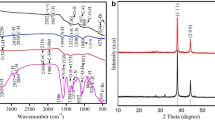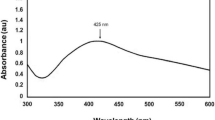Abstract
The present study deals with the synthesis of silver nanoparticles (AgNPs) from Rhynchosia rufescens and to evaluate its cytotoxic effect mediated through induced apoptosis. The reduction and cap** of phytoconstituents was confirmed using FTIR demonstrating O–H and C–H stretching at different peaks. The size and the shape of the particle were determined using scanning electron microscopy (SEM) illustrating 1 μm to 100 nm in size and the composition of compounds in the AgNPs were revealed using XRD and EDX. The results of the antioxidant assays revealed that the synthesized AgNPs had significant radical scavenging potential in dose-dependent inhibition with 22–64% for DPPH and 25–41% for ferric reducing antioxidant power assay at the concentrations of 20–100 μg/ml. Further, the synthesized AgNPs demonstrated potent cytotoxic activity against human breast cancer (MCF-7) cell line with an IC50 value of 26 ± 1.0 μg/ml by the MTT assay. Cytotoxicity was confirmed using AO/EtBr and DAPI staining method where nuclear condensation and fragmentation of cancer cells was observed after treatment with nanoparticle. The results were further confirmed by flow cytometry analysis which revealed the occurrence of apoptosis during the S phase in cell cycle exposing the potential of the AgNPs against MCF-7 cancer cell. From the results, we conclude that the synthesized AgNPs from Rhynchosia rufescens exhibited multifunctional properties.

Graphical abstract












Similar content being viewed by others
References
Abdol mohammadi MH, Fouladdel SH, Shafiee A, Amin GH Ghaffari SM, Azizi E (2008) Anticancer effects and cell cycle analysis on human breast cancer T47D cells treated with extracts of Astrodaucus persicus (Boiss.) Drude in comparison to Doxorubicin. DARU- Journal of Faculty of Pharmacy 16(2):112–118
Ahmed KSZ, Sidhra S, Ponmurugan P, Senthil Kumar B (2016) Ameliorative potential of Solanum trilobatum on oxidative stress in alloxan induced diabetic rats. Pakistan Journal of Pharmaceutical Sciences 29(5):1571–1578
Asharani PV, Low G, Mun K, Hande MP, Valiyaveettil S (2009) Cytotoxicity and genotoxicity of silver. ACS Nano 3(2):279–290. https://doi.org/10.1021/nn800596w
Chazotte B (2011) Labeling nuclear DNA using DAPI. Cold Spring Harbor protocols. https://doi.org/10.1101/pdb.prot5556
Chou CC, Yang JS, Lu HF, Ip SW, Lo C (2010) Quercentin-mediated cell cycle arrest and apoptosis involving activation of a caspase cascade through the mitochondrial pathway in human breast cancer MCF-7 cell lines. Archives of Pharmacal Research 33(8):1181–1191. https://doi.org/10.1007/s12272-010-0808-y
Das K, Roychoudhury A (2014) Reactive oxygen species (ROS) and response of antioxidants as ROS-scavengers during environmental stress in plants. Frontiers in Environmental Science. https://doi.org/10.3389/fenvs.2014.00053
El-Chaghaby GA, Ahmad AF (2011) Biosynthesis of silver nanoparticles using Pistacia lentiscus leaves extract and investigation of their antimicrobial effect. Oriental Journal of Chemistry 27:929–936
El-Naggar NEA, Hussein MH, El-Sawah AA (2017) Bio-fabrication of silver nanoparticles by phycocyanin, characterization, in vitro anticancer activity against breast cancer cell line and in-vivo cytotoxicity. Scientific Reports 7:10844. https://doi.org/10.1038/s41598-017-11121-3
Elumalai EK, Prasad TNVKV, Hemachandran J, Vivian Therasa S, Tirumalai T, David E (2010) Extracellular synthesis of silver nanoparticles using leaves of Euphorbia hirta and their antibacterial activities. Journal of Pharmaceutical Sciences and Research 2:549–554
Farah MA, Ali MA, Chen SM, Li Y, Al-Hemaid FM, Abou-Tarboush FM, Al-Anazi KM, Lee J (2016) Silver nanoparticles synthesized from Adenium obesum leaf extract induced DNA damage, apoptosis and autophagy via generation of reactive oxygen species. Colloids and Surfaces B: Biointerfaces 141:158–169. https://doi.org/10.1016/j.colsurfb.2016.01.027
Forough M, Farhadi (2010) Biological and green synthesis of silver nanoparticles. Turkish Journal of Engineering and Environmental Sciences 34:281–287. https://doi.org/10.3906/muh-1005-30
Gajendran B, Chinnasamy A, Durai P, Jegadeesh Raman J, Ramar M (2014) Biosynthesis and characterization of silver nanoparticles from Datura inoxia and its apoptotic effect on human breast cancer cell line MCF7. Materials Letters 122:98–102. https://doi.org/10.1016/j.matlet.2014.02.003
Jemal A, Bray F, Center MM, Ferlay J, Ward E, Forman D (2011) Global cancer statistics. CA Cancer Journal for Clinicians 61:69–90. https://doi.org/10.3322/caac.20107
Kalaiarasi K, Prasannaraj G, Sahi SV, Venkatachalam P (2015) Phytofabrication of biomolecules coated metallic silver nanoparticles using leaf extracts of in vitro raised bamboo species and its anticancer activity against human PC3 cell lines. Turkish Journal of Biology 39:223–232. https://doi.org/10.3906/biy-1406-10
Kalidass C, Mohan VR (2012) Biochemical composition and nutritional assessment of selected under-utilized food legume of the genus Rhynchosia. International Food Research Journal 19(3):977–984
Kavithaa K, Paulpandi M, Padma PR, Sumathi S (2016) Induction of intrinsic apoptotic pathway and cell cycle arrest via baicalein loaded iron oxide nanoparticles as a competent nanomediated system for triple negative breast cancer therapy. RSC Advances 6:64531–64543. https://doi.org/10.1039/C6RA11658B
Khan MI, Mohammad A, Patil G, Naqvi SA, Chauhan LK, Ahmad I (2012) Induction of ROS, mitochondrial damage and autophagy in lung epithelial cancer cells by iron oxide nanoparticles. Biomaterials 33:1477–1488
Liu M, Li R, Tang Y, Chang J, Han R, Zhang S, Jiang N, Ma F (2017) New applications of acridine orange fluorescence staining method: screening for circulating tumor cells. Oncology Letters 13:2221–2229. https://doi.org/10.3892/ol.2017.5724
Loutfy S, Al-Ansary NA, Abdel-Ghani NT, Hamed AR (2015) Anti-proliferative activities of metallic nanoparticles in an in vitro breast cancer model. Asian Pacific Journal of Cancer Prevention 16:6039–6046
Mallath MK, Taylor DG, Badwe RA, Rath GK, Shanta V, Pramesh CS, Digumarti R, Sebastian P, Borthakur BB, Kalwar A, Kapoor S (2014) The growing burden of cancer in India: epidemiology and social context. Lancet Oncology 15(6):70115–70119. https://doi.org/10.1016/S1470-2045(14)70115-9
MeenaKumari M, Jacob J, Philip D (2015) Green synthesis and applications of Au–Ag bimetallic nanoparticles. Spectrochimica Acta Part A Molecular and Biomolecular Spectroscopy 137:185–192. https://doi.org/10.1016/j.saa.2014.08.079
Mohamed Rafi M, Syed Zameer Ahmed K, Prem Nazeer K, Siva Kumar D, Thamilselvan M (2015a) Antibacterial activity of iron oxide nanoparticles on polysaccharide templates: synthesis, characterization and magnetic studies. Malaysian Polymer Journal 10(1):16–22
Mohamed Rafi M, Syed Zameer Ahmed K, Prem Nazeer K, Siva Kumar D, Thamilselvan M (2015b) Synthesis, characterization and magnetic properties of hematite (a-Fe2O3) nanoparticles on polysaccharide templates and their antibacterial activity. Applied Nanoscience 5:515–520. https://doi.org/10.1007/s13204-014-0344-z
Oves M, Aslam M, Rauf MA, Qayyum S (2018) Antimicrobial and anticancer activities of silver nanoparticles synthesized from the root hair extract of Phoenix dactylifera. Materials Science and Engineering: C 89:429–443. https://doi.org/10.1016/j.msec.2018.03.035
Oyaizu M (1986) Studies on product of browning reaction prepared from glucose amine. Japanese Journal of Nutrition 44:307–315. https://doi.org/10.5264/eiyogakuzashi.44.307
Poongothai K, Ponmurugan P, Syed Zameer Ahmed K, Senthil Kumar B, Sheriff SA (2011) Antihyperglycemic and antioxidant effects of Solanum xanthocarpum leaves (field grown & in vitro raised) extracts on alloxan induced diabetic rats. Asian Pacific Journal of Tropical Medicine 4(10):778–785. https://doi.org/10.1016/S1995-7645(11)60193-4
Preethi K, Vijayalakshmi N, Shamna R, Sasikumar JM (2010) In vitro antioxidant activity of extracts from fruits of Muntingia calabura Linn. from India. Pharmacognosy Journal 2(14):11–18. https://doi.org/10.1016/S0975-3575(10)80065-3
Rajan R, Chandran K, Harper SL, Yun S, Kalaichelvan PT (2015) Plant extract synthesized silver nanoparticles, an ongoing source of novel biocompatible materials. Industrial Crops and Products 70:356–373. https://doi.org/10.1016/j.indcrop.2015.03.015
Rashidi M, Ahmadzadeh A, Ziai SA, Narenji M, Jamshidi H (2016) Evaluating cytotoxic effect of nanoliposomes encapsulated with umbelliprenin on 4T1 cell line. In Vitro Cellular & Developmental Biology - Animal 53:7–11. https://doi.org/10.1007/s11626-016-0080-7
Rege A, Juvekar P, Juvekar A (2012) In vitro antioxidant and anti-arthritic activities of shilajit. International Journal of Pharmaceutical Sciences and Research 4(2):650–653
Shaikh R, Pund M, Dawane A, Iliyas S (2014) Evaluation of anticancer, antioxidant and possible anti-inflammatory properties of selected medicinal plants used in Indian traditional medication. Journal of Traditional and Complementary Science 4(4):253–257. https://doi.org/10.4103/2225-4110.128904
Shimada K, Fujikawa K, Yahara K, Nakamura T (1992) Antioxidative properties of xanthan on the antioxidation of soybean oil in cyclodextrin emulsion. Journal of Agricultural and Food chemistry 40:945–948. https://doi.org/10.1021/jf00018a005
Sidhra S, Syed Zameer Ahmed K, Krishnaveni R, Anupriya B, Senthil Kumar B, Kishore R (2017) Modulatory effect of Leucas aspera on oxidative stress and glucose metabolism against diabetic complications in experimental rats. International Research Journal of Pharmacy 8(8):27–33
Sidhra S, Syed Zameer Ahmed K, Vanmathi M, Muniraj C, Venkatesan T, Karamchand R, Manimaran V (2019) Antiobesity and antihyperlipidemic effect of Ixora coccinea on triton-X100 induced hyperlipidemia in rats- an approach to evaluate asymmetrical temperature distribution analysis using thermography. Chinese Herbal Medicines. 11:326–331. https://doi.org/10.1016/j.chmed.2019.05.006
Singh U, Jialal I (2012) Oxidative stress and atherosclerosis. Pathophysiology 13:129–142
Syed Zameer Ahmed K, Sidhra S, Senthil Kumar B, Thanga Kumar A, Geetha K, Mohamed Rafi M, Ponmurugan P, Kishore R (2017) Modulatory effect of dianthrone rich alcoholic flower extract of Cassia auriculata L. on experimental diabetes. Integrative Medicine Research 6:131–140. https://doi.org/10.1016/j.imr.2017.01.007
Syed Zameer Ahmed K, Sidhra S, Jagadeeswari S, Mohamed Rafi M, Kishore R (2018a) A comparative study on larvicidal potential of selected medicinal plants over green synthesized silver nano particles. Egyptian Journal of Basic and Applied Sciences 5(1):54–62. https://doi.org/10.1016/j.ejbas.2018.01.002
Syed Zameer Ahmed K, Sidhra S, Thangakumar A, Sanjeeva N, Senthil Kumar B, Syed Tajudeen S, Ponmurugan P (2018b) Radical scavenging potential, antiinflammatory and antiarthritic activity of isolated isomer methyl-γ-orsellinate and roccellatol from Roccella Montagnei. Bulletin of Faculty of Pharmacy, Cairo University 56(1):39–45. https://doi.org/10.1016/j.bfopcu.2018.02.001
Syed Zameer Ahmed K, Sidhra S, Thangakumar A, Krishnaveni R (2019) Therapeutic effect of Parmotrema tinctorum against complete Freund’s adjuvant-induced arthritis in rats and identification of novel isophthalic ester derivative. Biomed. Pharmacother 112:108646. https://doi.org/10.1016/j.biopha.2019.108646
Vivek R, Thangam R, Muthuchelian K, Gunasekaran P, Kaveri K (2012) Green biosynthesis of silver nanoparticles from Annona squamosa leaf extract and it’s in-vitro cytotoxic effect on MCF-7 cells. Process Biochemistry 47:2405–2410. https://doi.org/10.1016/j.procbio.2012.09.025
Acknowledgments
The authors are grateful to the management and Principal of K.S.Rangasamy College of Technology for providing infrastructure to carry out this research work. Authors are thankful to the infrastructure provided by DST-FIST, India, and DBT-STAR Scheme, India.
Author information
Authors and Affiliations
Corresponding author
Additional information
Responsible editor: Philippe Garrigues
Publisher’s note
Springer Nature remains neutral with regard to jurisdictional claims in published maps and institutional affiliations.
Rights and permissions
About this article
Cite this article
Khader, S.Z.A., Syed Zameer Ahmed, S., Ganesan, G.M. et al. Rhynchosia rufescens AgNPs enhance cytotoxicity by ROS-mediated apoptosis in MCF-7 cell lines. Environ Sci Pollut Res 27, 2155–2164 (2020). https://doi.org/10.1007/s11356-019-06479-y
Received:
Accepted:
Published:
Issue Date:
DOI: https://doi.org/10.1007/s11356-019-06479-y




